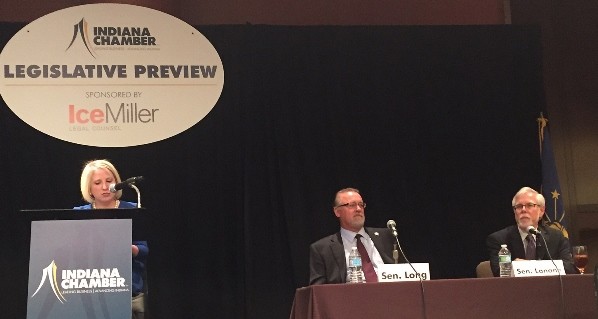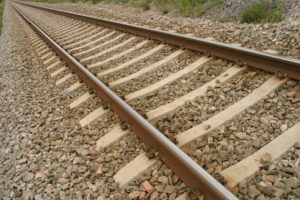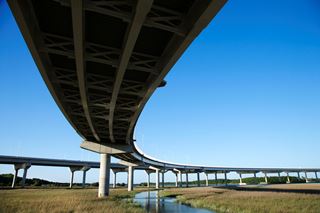
Senate Democratic Leader Tim Lanane (right) speaks during Monday’s Indiana Chamber Legislative Preview. He was joined during the panel discussion by Senate President Pro Tem David Long, as well as House Speaker Brian Bosma and Minority Leader Scott Pelath. Our VP Caryl Auslander moderated.
Long-term transportation infrastructure funding, expansion of state-funded preschool to children from low-income families and strategies to reduce the state’s smoking rate are among the Indiana Chamber of Commerce’s top priorities for the 2017 session.
These objectives were announced at the organization’s annual legislative preview in Indianapolis today. The event sponsor was Ice Miller LLP.
“Based on studies, reports and simply travelling across the state, it’s pretty apparent that what we desperately need is a long-term, sustainable, transportation infrastructure funding plan,” offers Indiana Chamber President and CEO Kevin Brinegar.
He believes whatever strategies are ultimately settled on to fund the state’s road and bridges, two factors must be taken into consideration.
“We need to completely fund both maintenance needs and important new projects, and ensure that every user pays their fair share.”
Specific funding strategies the Indiana Chamber could support include: indexing the fuel excise taxes/fees to inflation; raising fuel excise taxes/fees; charging fees for alternative-fuel vehicles (which aren’t subject to the regular fuel tax); tolling a major interstate; and dedicating all of the sales taxes on fuel to infrastructure (the current model allots a penny with the other six cents going to the state’s general fund).
Brinegar notes that the Indiana Chamber would support replacing any revenue lost to the general fund with another revenue source so that the general fund is left whole.
Education is also high on the organization’s agenda.
“We are encouraged that virtually everyone involved sees the need to increase state-funded preschool,” Brinegar begins. “The Indiana Chamber will be advocating that disadvantaged youngsters take priority for the state’s limited dollars.
“We want to see legislators focus on fiscal responsibility, ensure preschool programs are of high quality and adopt a mixed delivery model that includes public schools, Head Start programs, licensed family and center-based childcare, as well as community-based organizations. All of those things are vitally important.”
The Indiana Chamber is part of the All IN 4 Pre-K coalition.
Separately, the Indiana Chamber is supporting suitable testing for students and accountability measures for all involved in the education process.
“Clearly there have been issues with ISTEP testing and the communication of result expectations based on the state’s new college and career-ready standards,” Brinegar says. “But the fundamental importance of measuring students, teachers and schools remains. That’s how we can predict student progress, rate teacher effectiveness and compare and contrast school performance relative to state and national peers.”
Indiana ranks 44th in the nation for highest percentage of smokers. Brinegar stresses that the increased health care costs associated with this level of smoking has the attention of employers.
“These workers are less healthy, have higher insurance premiums and miss more days on the job – and some are not able to work at all.”
The Indiana Chamber, a member of the new Alliance for a Healthier Indiana, is backing a comprehensive approach to reducing the state’s smoking rate. The proposal includes: raising the price of cigarettes via a tax increase; funding a more robust smoking cessation program; increasing the smoking age from 18 to 21; and repealing special privileges for smokers (that prohibit employers from asking possible new hires if they smoke).
“Right now, Indiana is spending substantially more on smokers with health issues who are on Medicaid than it is taking in via cigarette tax revenues. For every pack sold and taxed at 99.5 cents, the state spends at least $15.90 in related health care costs,” Brinegar states. “Obviously that’s not a sustainable tradeoff and needs the state’s attention.”
In the summer, the Indiana Chamber more closely aligned with the state’s technology industry, forming the Indiana Technology & Innovation Council to facilitate better communication and coordination among interested parties.
According to Brinegar, a key focus is public policy so technology leaders can present a strong, unified voice at the Statehouse. Out of the gate, the goal is to “make technology innovation an integral part of the state’s identity.”
Brinegar says: “Indiana is already fostering an impressive entrepreneurial spirit and becoming a technology hub in the Midwest. But we need to better support our technology successes and build on them. After all, our technology efforts now provide tremendous support to the agriculture, logistics and manufacturing sectors in the state – three of our main cogs.”
The Technology and Innovation Policy Summit on December 15 will unveil all the council’s legislative goals.
A complete rundown of the Indiana Chamber’s 2017 key legislative initiatives (top priorities and additional areas of focus) is available at www.indianachamber.com/priorities.
Also at the legislative preview event, five state legislators were honored as Indiana Chamber Small Business Champions “for their hard work and dedication to improving Indiana’s small business climate.” This award is based on voting and advocacy during the past legislative session.
The 2016 Small Business Champions are: Sen. Travis Holdman from Markle, District #19; Sen. Tim Lanane from Anderson, District #25; Rep. Matt Lehman from Berne, District #79; Rep. Karlee Macer from Indianapolis, District# 92; and Rep. Ed Soliday from Valparaiso, District #4.
Recap of the Indiana Chamber’s Top 8 legislative priorities:
- Support establishing a long-term sustainable funding stream for the state’s roads, bridges, etc.
- Support the expansion of publicly-funded preschool initiatives for children from low income families
- Support suitable testing for students and accountability for all involved in the education process
- Support comprehensive approach to decreasing the state’s smoking rate
- Support a statewide water policy to assure future resources and our economic prosperity
- Support making technology innovation an integral part of the state’s identity
- Support maintaining and enhancing our attractive tax climate
- Support a work share program that will allow employers to maintain a skilled stable workforce during temporary downturns



 Indiana Sen. Joe Donnelly discussed a wide variety of issues with members of the Indiana Chamber’s Executive Committee during an hour-long visit last week. Among his comments on the issues before Congress:
Indiana Sen. Joe Donnelly discussed a wide variety of issues with members of the Indiana Chamber’s Executive Committee during an hour-long visit last week. Among his comments on the issues before Congress: SB 128
SB 128

 The political wrangling between the House and Senate over the roads bill is in full swing. This bill has been substantially altered by the Senate Appropriations Committee at the direction of its chairman, Sen. Luke Kenley (R-Noblesville). Essentially, Kenley’s amendment removes all tax increases and decreases from the bill and establishes a task force to further assess the state’s needs for road funding – putting off difficult decisions to 2017.
The political wrangling between the House and Senate over the roads bill is in full swing. This bill has been substantially altered by the Senate Appropriations Committee at the direction of its chairman, Sen. Luke Kenley (R-Noblesville). Essentially, Kenley’s amendment removes all tax increases and decreases from the bill and establishes a task force to further assess the state’s needs for road funding – putting off difficult decisions to 2017. Highways and bridges are easily taken for granted. They only come to mind for most of us when something goes wrong: A car hits a large pothole or there is an inconvenient road closure. But if you look around, the inevitable aging of our infrastructure system is happening.
Highways and bridges are easily taken for granted. They only come to mind for most of us when something goes wrong: A car hits a large pothole or there is an inconvenient road closure. But if you look around, the inevitable aging of our infrastructure system is happening.